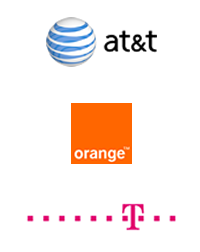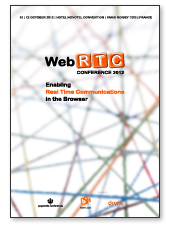| |
|
WEDNESDAY 10 OCTOBER 2012 | TECHNICAL TUTORIAL |
|
| |
|
|
|
| |
|
|
|
|
|
|
|
Tutorial presented by
Wolfgang Beck | Deutsche Telekom
Christian Hoene | Symonics GmbH
Dr. Daniel C. Burnett | Director of Standards | Voxeo |
|
| |
|
|
|
| |
|
Having standard APIs (Application Programming
Interfaces) and real-time audio and video capabilities and codecs
built-in to browsers will change the way we communicate, both in the
consumer and enterprise worlds. Web developers will be able to write
a few lines of JavaScript and add high quality voice and video
communication capabilities to their site or application. This tutorial introduces and explains the APIs and protocols of WebRTC.
The status of the W3C WEBRTC and the IETF RTCWEB standardization are covered. |
|
| |
|
|
|
| |
08.30 |
WELCOME, REGISTRATION AND COFFEE |
|
| |
|
MORNING SESSION |
|
| |
|
|
|
|
With the participation of:

Download the brochure in pdf

Co-located with
 |
|
10.00 |
WebRTC Overview
What is WebRTC; How to use WebRTC
Deployment architectures
Media flows in WebRTC
WebRTC protocols and IETF standards
|
|
| |
|
|
|
| |
10.45 |
COFFEE BREAK |
|
| |
|
|
|
| |
11.15 |
Using WebRTC
WebRTC W3C JavaScript APIs
JavaScript code example walkthrough |
|
| |
|
|
|
| |
|
|
|
| |
12.00 |
LUNCH |
|
| |
|
|
|
| |
|
AFTERNOON SESSION |
|
| |
|
|
|
| |
14.00 |
IETF Codec “Opus” Description
Introducing the internals of Opus and describing how it works, which algorithms are used, and how to use Opus.
The new IETF Codec “Opus” is ranging from narrowband to fullband. Furthermore, it is optimized for the Internet supporting frame length from 2.5 ms to 60 ms as well as for the adjustments of playout times. |
|
| |
|
|
|
| |
15.00 |
COFFEE BREAK |
|
| |
|
|
|
| |
15.30 |
RTCWeb for Telcos
Explaining why telcos can provide a more reliable service than OTTs by tayloring a service to their network. OTT players don‘t have to wait for standards and can implement new features quickly as they don't rely on any but the most basic functions of the underlying network.
Describing how RTCWEB can reduce the number of necessary standards by separating trust relationships from transport relationships. This can be achieved by combining RTCWEB and 3rd party authentication.
Demonstrating that IETF‘s smart endpoint philosophy allows every kind of application, but that the intractable endpoint diversity makes it hard to provide a consistent level of service. WEBRTC/RTCWEB has the potential to get the best out of both architectural philosophies. |
|
| |
|
|
|
|
| |
|
|
|
|
| |
|
16.30 |
END OF THE TECHNICAL TUTORIAL |
|



